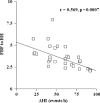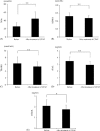Continuous positive airway pressure therapy improves vascular dysfunction and decreases oxidative stress in patients with the metabolic syndrome and obstructive sleep apnea syndrome
- PMID: 22278815
- PMCID: PMC6652717
- DOI: 10.1002/clc.21010
Continuous positive airway pressure therapy improves vascular dysfunction and decreases oxidative stress in patients with the metabolic syndrome and obstructive sleep apnea syndrome
Abstract
Background: Patients with obstructive sleep apnea syndrome (OSAS) are always exposed to intermittent hypoxia and reoxygenation. The metabolic syndrome (MetS) and OSAS are also known to accelerate atherosclerosis, diabetes, and dyslipidemia. Therefore, nasal continuous positive airway pressure (CPAP) therapy may have beneficial effects in patients with the MetS and OSAS.
Hypothesis: This study in patients with the MetS and OSAS tested the validity of the hypothesis that chronic CPAP therapy improves factors involved in atherosclerosis, including impaired endothelial function.
Methods: Thirty-two patients (19 males and 13 females, mean age 54 ± 9 y) diagnosed with the MetS and OSAS were enrolled in the study and received CPAP therapy for 3 months. Vascular function was investigated by measuring forearm blood flow (FBF) responses to reactive hyperemia (RH) using venous occlusion strain-gauge plethysmography. Biochemical markers were also measured before and after this procedure.
Results: Basal apnea-hypopnea index was statistically correlated with FBF response to RH. The FBF response to RH was increased significantly after 3 months of CPAP therapy. A significant increase in plasma nitric oxide levels and a decrease in the levels of asymmetrical dimethylarginine, thiobarbituric acid reactive substance, soluble Fas ligand, and soluble CD40 ligand were detected after CPAP therapy. The plasma concentrations of tumor necrosis factor-α, interleukin (IL)-6, and IL-8 also decreased significantly with CPAP therapy, whereas IL-1β levels remained unchanged.
Conclusions: Continuous positive airway pressure therapy has beneficial effects on vascular function and inflammatory and oxidative stress in patients with the MetS and OSAS.
© 2012 Wiley Periodicals, Inc.
Figures




Similar articles
-
Intrarenal hemodynamic and oxidative stress in patients with obstructive sleep apnea syndrome.Sleep Breath. 2015 Dec;19(4):1205-12. doi: 10.1007/s11325-015-1140-z. Epub 2015 Apr 1. Sleep Breath. 2015. PMID: 25827500
-
Oxidative and carbonyl stress in patients with obstructive sleep apnea treated with continuous positive airway pressure.Sleep Breath. 2012 Jun;16(2):393-8. doi: 10.1007/s11325-011-0510-4. Epub 2011 Mar 26. Sleep Breath. 2012. PMID: 21437776
-
Sex differences of continuous positive airway pressure treatment on flow-mediated dilation in patients with obstructive sleep apnea syndrome.Clin Interv Aging. 2015 Aug 19;10:1361-6. doi: 10.2147/CIA.S84199. eCollection 2015. Clin Interv Aging. 2015. PMID: 26316731 Free PMC article.
-
Effect of continuous positive airway pressure on lipid profile in patients with obstructive sleep apnea syndrome: a meta-analysis of randomized controlled trials.Atherosclerosis. 2014 Jun;234(2):446-53. doi: 10.1016/j.atherosclerosis.2014.03.034. Epub 2014 Apr 12. Atherosclerosis. 2014. PMID: 24769714 Review.
-
Impact of continuous positive airway pressure on vascular endothelial growth factor in patients with obstructive sleep apnea: a meta-analysis.Sleep Breath. 2019 Mar;23(1):5-12. doi: 10.1007/s11325-018-1660-4. Epub 2018 Apr 18. Sleep Breath. 2019. PMID: 29671205 Review.
Cited by
-
Endothelial dysfunction and coronary artery disease: assessment, prognosis, and treatment.Coron Artery Dis. 2014 Dec;25(8):713-24. doi: 10.1097/MCA.0000000000000178. Coron Artery Dis. 2014. PMID: 25365643 Free PMC article. Review.
-
Oxidative stress management during non-invasive ventilation in acute respiratory failure.Intern Emerg Med. 2018 Mar;13(2):141-142. doi: 10.1007/s11739-017-1779-5. Epub 2017 Dec 21. Intern Emerg Med. 2018. PMID: 29270832 No abstract available.
-
Diagnostic capability of biological markers in assessment of obstructive sleep apnea: a systematic review and meta-analysis.J Clin Sleep Med. 2015 Jan 15;11(1):27-36. doi: 10.5664/jcsm.4358. J Clin Sleep Med. 2015. PMID: 25325575 Free PMC article.
-
Management of non-alcoholic fatty liver disease patients with sleep apnea syndrome.World J Gastroenterol. 2022 Nov 21;28(43):6099-6108. doi: 10.3748/wjg.v28.i43.6099. World J Gastroenterol. 2022. PMID: 36483151 Free PMC article. Review.
-
Patients with obstructive sleep apnea have suppressed levels of soluble cytokine receptors involved in neurodegenerative disease, but normal levels with airways therapy.Sleep Breath. 2021 Sep;25(3):1641-1653. doi: 10.1007/s11325-020-02205-y. Epub 2020 Oct 9. Sleep Breath. 2021. PMID: 33037528 Free PMC article.
References
-
- Gami AS, Witt BJ, Howard DE, et al. Metabolic syndrome and risk of incident cardiovascular events and death: a systematic review and meta‐analysis of longitudinal studies. J Am Coll Cardiol. 2007;49:403–414. - PubMed
-
- McCurry J. Japanese people warned to curb unhealthy lifestyles: health experts urge a return to dietary basics to prevent future health problems. Lancet. 2004;363:1126. - PubMed
-
- Peppard PE, Young T, Palta M, et al. Prospective study of the association between sleep‐disordered breathing and hypertension. N Engl J Med. 2000;342:1378–1384. - PubMed
-
- Nieto FJ, Young TB, Lind BK, et al. Association of sleep‐disordered breathing, sleep apnea, and hypertension in a large community‐based study: Sleep Heart Health Study. JAMA. 2000;283:1829–1836. - PubMed
MeSH terms
Substances
LinkOut - more resources
Full Text Sources
Medical
Research Materials
Miscellaneous

